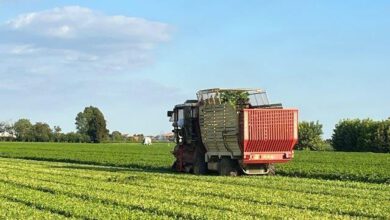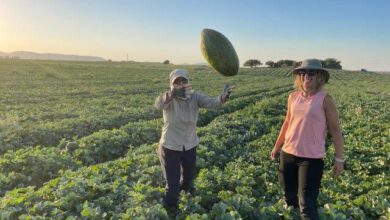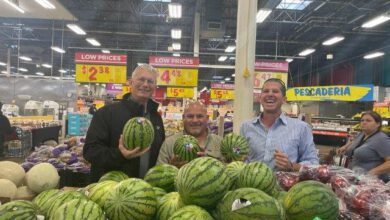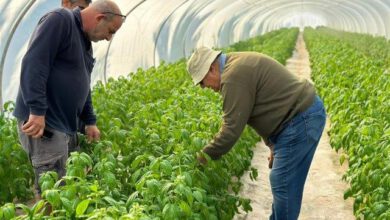How do grafting and growing region affect the quality of seedless watermelon fruit ?
Grafting can protect vegetables against soil-borne diseases and nematodes
Elazar Fallik*, Sharon Alkalai-Tuvia, Merav Zaaroor-Presman, Daniel Chalupovicz*

the commercial use of grafted vegetable transplants has been practiced for over 50 years in east asia to overcome crop limitations associated with intensive cultivation on limited and challenging arable land. grafting can protect vegetables against soil-borne diseases and nematodes, against abiotic stresses such as high/low temperatures, salinity, drought or excessive soil-water content, and against elevated soil concentrations of heavy metals and organic pollutants.
in addition, the grafted plant takes up water and nutrients from the soil more efficiently and retains its vitality for longer periods during the growing season. however, rootstock/scion combinations may affect and alter the final size, yield, and quality of fruits from grafted plants, both immediately after postharvest and during prolonged storage. these changes may be attributed in part to differing production environments and methods, the type of rootstock/scion combinations, and harvest date.
watermelon (citrullus lanatus l.) fruits in the mediterranean basin are usually stored after harvest under non-refrigerated conditions for several days. however, the quality and shelf life of grafted watermelons vary among cultivars and appear to depend upon both the rootstock and the scion. hence, grafting can increase yield and fruit size, and improve or reduce fruit external and/or internal quality, depending on the specific rootstock/scion combination (picture 1).
in addition, inconsistencies in fruit quality and shelf life parameters can be attributed to differences in production environments, including time of harvest. however, many farmers plant the same rootstock/scion combination in all regions of israel, despite diffferences in soil, water and weather conditions.
in this paper we will demonstrate how watermelon fruit quality problems (picture 2) can be affected by grafting two different varieties in two different growing regions.
the experiments were carried out during 2018 at kibbutz kalia, in the dead sea area with the following scions; cv. fashion (midi fruit, 5-7 kg, dark green – yam tichon seeds, ltd, israel) and aramis (maxi, 7-11 kg, oval, green stripes – bayer, ltd), (harvested on 29.4.2018) and in eden r&d agricultural research station located in the bet she’an valley with cv. fashion (harvested on 23.5.2018).
scions (varieties fashion and aramis) were grafted onto inter-specific cucurbita maxima x cucurbita moshata rootstocks in each region as shown in table 1. fruits were harvested according to commercial harvest indications (tendril and stem dryness, size and skin color) and were stored at 20°c for 4 days. quality parameters presented here are directly related to fruit sensory characteristics; sugar content in the middle of the fruit (expressed as % of brix°, measured with a digital refractometer); flesh texture was evaluated on a scale of 1 to 3, where 1 = very soft; 2 = firm; 3 = very firm and crispy; overall taste on a scale of 1 to 3, where 1= bad; 2 = good; 3 = excellent. both flesh texture and overall taste were evaluated by a panel of 6 trained evaluators.
 |
table 1: the combination of rootstock and scion that were planted in two growing regions
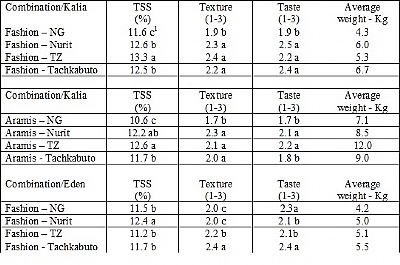 |
table 2: the influence of rootstock and scion on several watermelon quality parameters after 4 d at 20°c. each treatment included 8 fruits
1 values followed by the same letter do not significantly differ between the treatments at p=0.05 according to duncan’s multiple range test. each growing region was statistically analyzed separately.
growing the same combinations of rootstock and scion in two different growing regions resulted in different internal qualities (table 2). in the kalia region, fruit texture was firmer and crisper than the fruit texture in the eden region, even with identical rootstock/scion combinations. sugar content and texture are the two most important parameters that influence both taste and how the food feels in our mouth while eating.
in the kalia region, the combination of fashion/nurit and fashion/tachkabuto ranked best in taste, while in fruit grown in the eden region, non-grafted fashion and fashion/tachkabuto had the best overall taste.
several factors may affect postharvest fruit quality; variety (genetic background), weather conditions, preharvest practices such as soil type, fertigation, plant shape, etc., postharvest practices such as maturity harvesting, time of harvest, packinghouse operation, cold storage, transportation, etc., and all these factors combined. in each region, due to the factors which are involved in fruit quality, growing the same combination of rootstock/scion might affect negatively fruit sensory quality which in turn will affect consumer acceptance, although fruit is harvested based on fruit color, size, and tendril and stem dryness.
therefore, based on the results shown here and our results for the last 4 years, it is highly necessary that more research should be conducted in order to find the best rootstock/scion combination for producing the highest quality fruit from the consumer’s point of view.
acknowledgment: this research was funded by the chief scientist of the ministry of agriculture and rural development no. 430-0598-16/17. contribution from the agricul¬tural research organization, the volcani center, rishon leziyyon, israel, no. 826/18.
.jpg) |
picture 1: the effect of grafting on fruit size and internal quality
.jpg) |
picture 2: internal quality defects as affected by rootstock/scion combination. 1) unripe fruit [harvested too early], thick rind; 2) internal cracking and too many seeds; 3) flesh breakdown [virus infection]; 4) heart cracking; 5) uneven internal ripening and very thick rind; 6) white fibers; 7) black seeds; 8) good internal quality [red and uniform flesh, few white seeds, very thin white fiber]
aro, the volcani center, department of postharvest science of fresh produce, rishon leziyyon, 7505101, israel.
*corresponding author: efallik@volcani.agri.gov.il; tel.: +972-3-9683665

